How to spot phishing campaigns like "Office Printer"
Phishing/ScamAlso Known As: Office Printer phishing email
Get free scan and check if your device is infected.
Remove it nowTo use full-featured product, you have to purchase a license for Combo Cleaner. Seven days free trial available. Combo Cleaner is owned and operated by RCS LT, the parent company of PCRisk.com.
What kind of email is "Office Printer"?
After evaluating this email, our team has concluded that it is a fraudulent email sent by scammers with the intention of deceiving recipients and obtaining their personal information. The email is designed to appear as if it pertains to a new scanned document and includes links to a phishing website. Recipients should disregard this email.
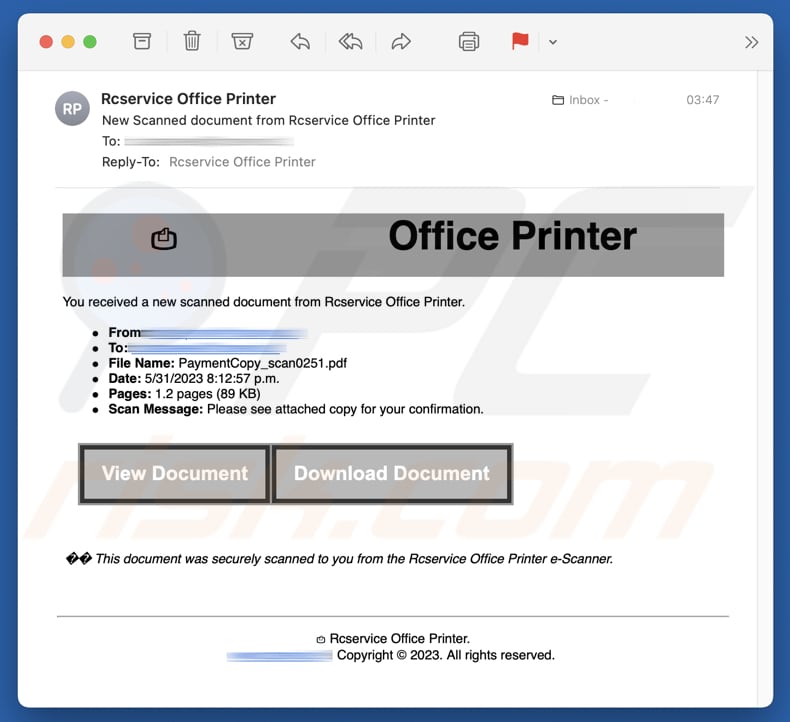
More about the "Office Printer" scam email
The email appears to be a phishing attempt disguised as a notification from "Office Printer". The subject line indicates the receipt of a new scanned document, and the email includes details such as the sender, recipient, file name ("PaymentCopy_scan0251.pdf"), date, number of pages, and a scan message instructing the recipient to review the attached copy for confirmation.
The email provides two options: to view the document or to download it, both of which are accompanied by buttons labeled "View Document" and "Download Document". Additionally, there is a brief message stating that the document was securely scanned and sent via the Office Printer e-Scanner. The email concludes with a copyright notice indicating the year and asserting all rights reserved.
However, it is important to note that this email is a phishing attempt. The scammers behind the email aim to deceive unsuspecting recipients into clicking on the provided links. By doing so, recipients open a fraudulent website where the scammers attempt to extract passwords of email accounts.
Scammers can engage in various malicious activities when they obtain passwords for email accounts. Firstly, they can gain unauthorized access to the compromised email account and use it to send spam emails, make phishing attempts, or spread malware to the account owner's contacts.
Secondly, scammers can search through the account for sensitive information such as personal details, financial data, or login credentials for other online platforms, which can be used for identity theft or fraud.
Additionally, scammers may attempt to reset passwords for other accounts linked to the compromised email address, gaining control over multiple online accounts and potentially causing significant harm to the account owner.
| Name | Office Printer Email Scam |
| Threat Type | Phishing, Scam, Social Engineering, Fraud |
| Fake Claim | You have received a new scanned document |
| Related Domain (Phishing Website) | ipfs[.]io |
| Detection Names | ArcSight Threat Intelligence (Suspicious), CRDF (Malicious), CyRadar (Malicious), ESTsecurity (Phishing), SafeToOpen (Phishing), Full List Of Detections (VirusTotal) |
| Serving IP Address (ipfs[.]io) | 209.94.90.1 |
| Disguise | Notification from a printer |
| Symptoms | Unauthorized online purchases, changed online account passwords, identity theft, illegal access of the computer. |
| Distribution methods | Deceptive emails, rogue online pop-up ads, search engine poisoning techniques, misspelled domains. |
| Damage | Loss of sensitive private information, monetary loss, identity theft. |
| Malware Removal (Windows) |
To eliminate possible malware infections, scan your computer with legitimate antivirus software. Our security researchers recommend using Combo Cleaner. Download Combo CleanerTo use full-featured product, you have to purchase a license for Combo Cleaner. 7 days free trial available. Combo Cleaner is owned and operated by RCS LT, the parent company of PCRisk.com. |
Similar scam emails in general
Phishing emails often employ social engineering strategies to create a sense of urgency or fear, prompting recipients to take immediate action without thinking critically. Also, they mimic the appearance of legitimate emails from trusted sources, such as well-known companies, financial institutions, or government agencies, using logos, branding, and email formatting to deceive recipients.
Phishing emails commonly contain suspicious links or attachments that, when clicked or opened, can lead to the installation of malware or direct users to fake websites where personal information is collected. Examples of phishing emails are "Mailbox Restriction Notice Email Scam", "Alert! - Suspension Notice Email Scam", and "Payment Confirmation Email Scam".
How do spam campaigns infect computers?
Malware distribution through malspam campaigns involves the promotion of malicious files or links within emails. These files can come in various formats, such as archives (e.g., ZIP and RAR), executables (e.g., .exe and .run), documents (e.g., PDF and Microsoft Office), JavaScript files, ISO files, and more.
The infection chain is initiated when a user executes, runs, or opens such a file. For instance, Microsoft Office documents infect devices after executing malicious macro commands, while other files may require additional steps to be taken to drop malware.
How to avoid installation of malware?
Use caution when accessing email attachments or clicking on links received from unfamiliar or suspicious email addresses, especially if the email was unexpected. Ensure that your operating system, software, and plugins are up to date with the latest security patches. Keep your antivirus software regularly updated.
When downloading programs, rely on trusted sources and avoid downloading from peer-to-peer networks, questionable websites, or third-party downloaders. Exercise caution when encountering advertisements, pop-ups, or links on untrustworthy websites.
If you've already opened malicious attachments, we recommend running a scan with Combo Cleaner Antivirus for Windows to automatically eliminate infiltrated malware.
Text presented in the "Office Printer" email letter:
⎙ Office Printer
You received a new scanned document from Office Printer.
From:
To:
File Name: PaymentCopy_scan0251.pdf
Date: 5/31/2023 8:12:57 p.m.
Pages: 1.2 pages (89 KB)
Scan Message: Please see attached copy for your confirmation.
View Document Download Document
�� This document was securely scanned to you from the Office Printer e-Scanner.
⎙ Office Printer.
Copyright © 2023. All rights reserved.
Screenshot of the phishing website promoted via this email:
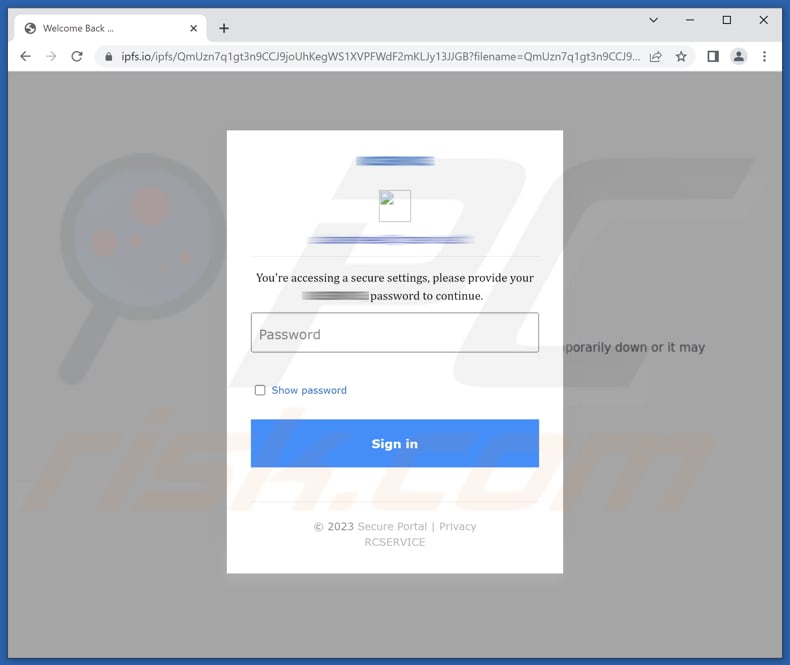
An Indonesian variant of an email from "Office Printer" spam campaign:
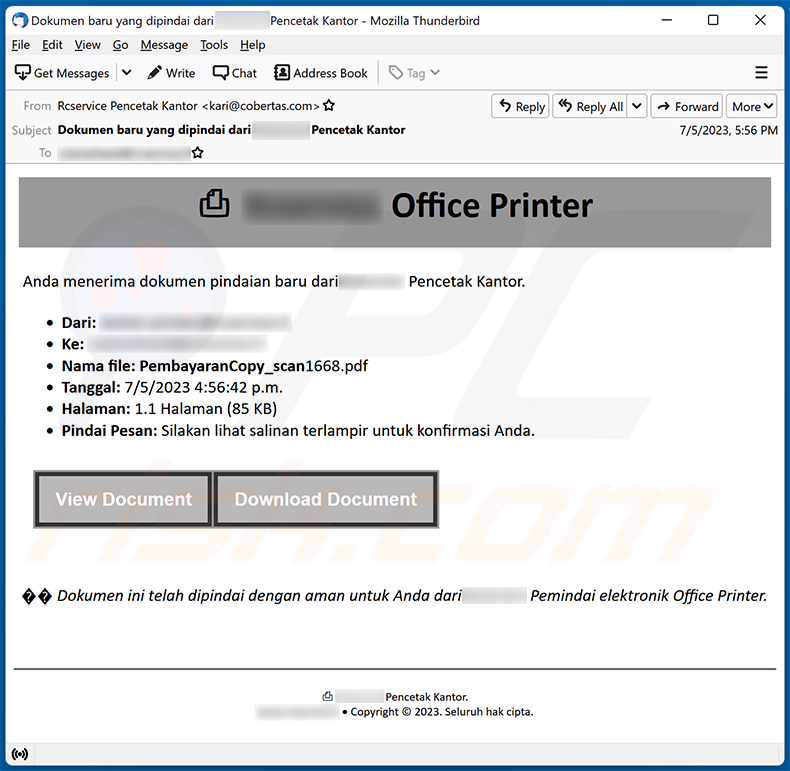
Text presented within:
Subject: Dokumen baru yang dipindai dari - Pencetak Kantor
- Office Printer
Anda menerima dokumen pindaian baru dari- Pencetak Kantor.Dari: -
Ke: -
Nama file: PembayaranCopy_scan1668.pdf
Tanggal: 7/5/2023 4:56:42 p.m.
Halaman: 1.1 Halaman (85 KB)
Pindai Pesan: Silakan lihat salinan terlampir untuk konfirmasi Anda.View Document Download Document
Dokumen ini telah dipindai dengan aman untuk Anda dari- Pemindai elektronik Office Printer.
- Pencetak Kantor.
- • Copyright © 2023. Seluruh hak cipta.
Yet another example of an email from "Office Printer" spam campaign:
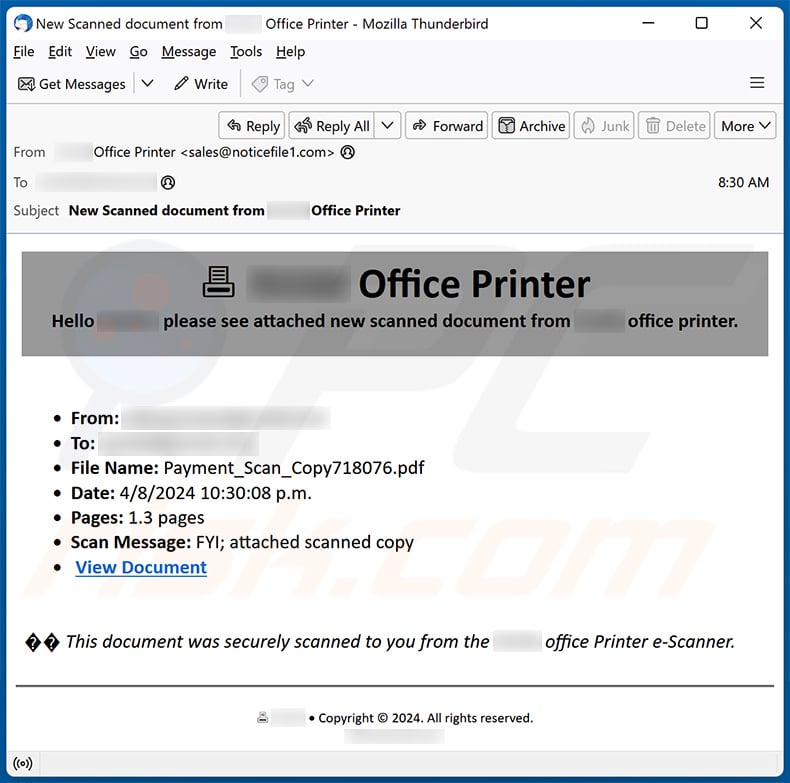
Text presented within:
Subject: New Scanned document from ******** Office Printer
******** Office Printer
Hello ********, please see attached new scanned document from ******** office printer.From: ********
To: ********
File Name: Payment_Scan_Copy718076.pdf
Date: 4/8/2024 10:30:08 p.m.
Pages: 1.3 pages
Scan Message: FYI; attached scanned copy
View Document
This document was securely scanned to you from the ******** office Printer e-Scanner.******** Copyright © 2024. All rights reserved.
www.********
Yet another example of an email from "Office Printer" spam campaign:
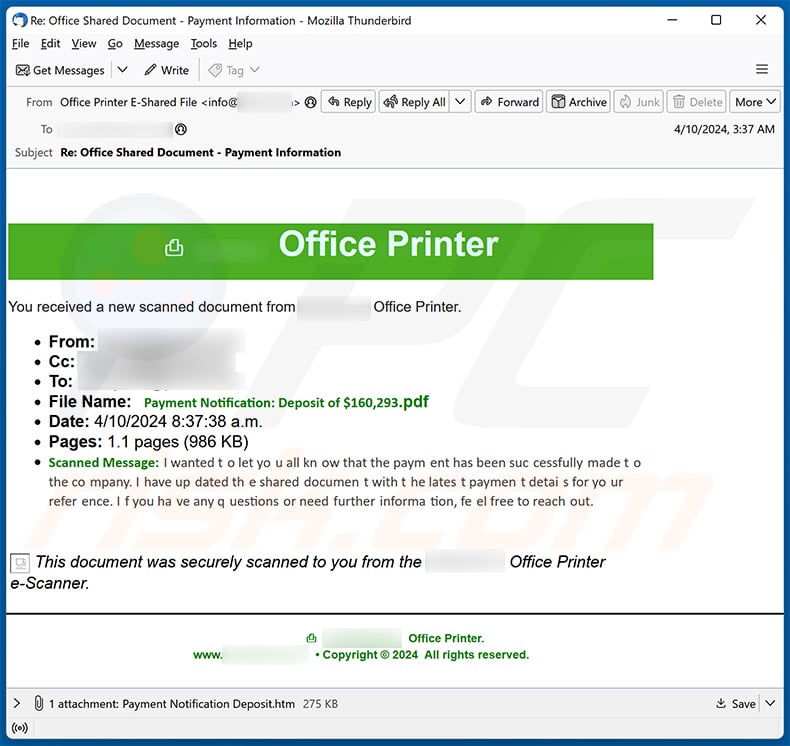
Text presented within:
Subject: Re: Office Shared Document - Payment Information
******** Office Printer
You received a new scanned document from ******** Office Printer.
From: ********
Cc: ********
To: ********
File Name: Payment Notification: Deposit of $160,293.pdf
Date: 4/10/2024 8:37:38 a.m.
Pages: 1.1 pages (986 KB)
Scanned Message: I wanted t o let yo u all kn ow that the paym ent has been suc cessfully made t o the co mpany. I have up dated th e shared documen t with t he lates t paymen t detai s for yo ur refer ence. I f you ha ve any q uestions or need further informa tion, fe el free to reach out.This document was securely scanned to you from the ******** Office Printer e-Scanner.
******** Office Printer.
www. ******** • Copyright © 2024 All rights reserved.
Screenshot of the attached HTML file designed for phishing purposes:
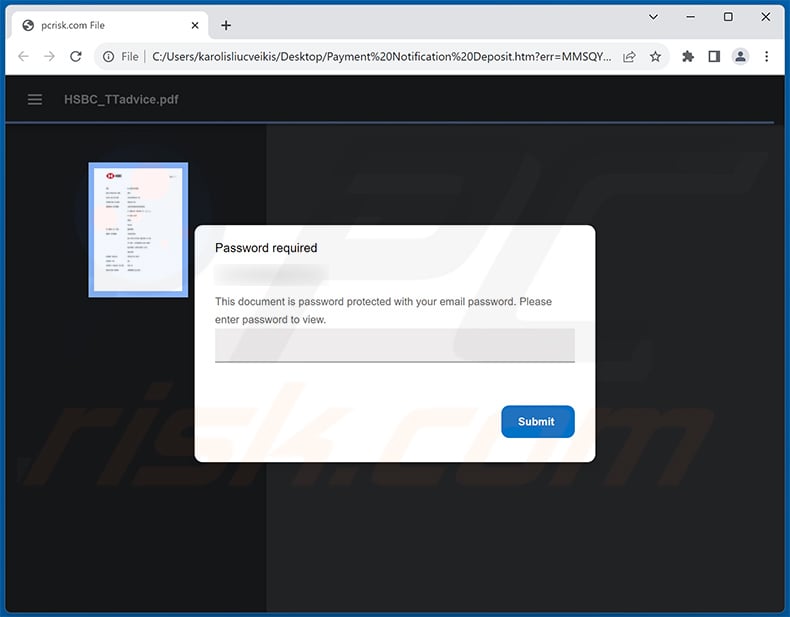
Instant automatic malware removal:
Manual threat removal might be a lengthy and complicated process that requires advanced IT skills. Combo Cleaner is a professional automatic malware removal tool that is recommended to get rid of malware. Download it by clicking the button below:
DOWNLOAD Combo CleanerBy downloading any software listed on this website you agree to our Privacy Policy and Terms of Use. To use full-featured product, you have to purchase a license for Combo Cleaner. 7 days free trial available. Combo Cleaner is owned and operated by RCS LT, the parent company of PCRisk.com.
Quick menu:
- What is Office Printer phishing email?
- Types of malicious emails.
- How to spot a malicious email?
- What to do if you fell for an email scam?
Types of malicious emails:
![]() Phishing Emails
Phishing Emails
Most commonly, cybercriminals use deceptive emails to trick Internet users into giving away their sensitive private information, for example, login information for various online services, email accounts, or online banking information.
Such attacks are called phishing. In a phishing attack, cybercriminals usually send an email message with some popular service logo (for example, Microsoft, DHL, Amazon, Netflix), create urgency (wrong shipping address, expired password, etc.), and place a link which they hope their potential victims will click on.
After clicking the link presented in such email message, victims are redirected to a fake website that looks identical or extremely similar to the original one. Victims are then asked to enter their password, credit card details, or some other information that gets stolen by cybercriminals.
![]() Emails with Malicious Attachments
Emails with Malicious Attachments
Another popular attack vector is email spam with malicious attachments that infect users' computers with malware. Malicious attachments usually carry trojans that are capable of stealing passwords, banking information, and other sensitive information.
In such attacks, cybercriminals' main goal is to trick their potential victims into opening an infected email attachment. To achieve this goal, email messages usually talk about recently received invoices, faxes, or voice messages.
If a potential victim falls for the lure and opens the attachment, their computers get infected, and cybercriminals can collect a lot of sensitive information.
While it's a more complicated method to steal personal information (spam filters and antivirus programs usually detect such attempts), if successful, cybercriminals can get a much wider array of data and can collect information for a long period of time.
![]() Sextortion Emails
Sextortion Emails
This is a type of phishing. In this case, users receive an email claiming that a cybercriminal could access the webcam of the potential victim and has a video recording of one's masturbation.
To get rid of the video, victims are asked to pay a ransom (usually using Bitcoin or another cryptocurrency). Nevertheless, all of these claims are false - users who receive such emails should ignore and delete them.
How to spot a malicious email?
While cyber criminals try to make their lure emails look trustworthy, here are some things that you should look for when trying to spot a phishing email:
- Check the sender's ("from") email address: Hover your mouse over the "from" address and check if it's legitimate. For example, if you received an email from Microsoft, be sure to check if the email address is @microsoft.com and not something suspicious like @m1crosoft.com, @microsfot.com, @account-security-noreply.com, etc.
- Check for generic greetings: If the greeting in the email is "Dear user", "Dear @youremail.com", "Dear valued customer", this should raise suspiciousness. Most commonly, companies call you by your name. Lack of this information could signal a phishing attempt.
- Check the links in the email: Hover your mouse over the link presented in the email, if the link that appears seems suspicious, don't click it. For example, if you received an email from Microsoft and the link in the email shows that it will go to firebasestorage.googleapis.com/v0... you shouldn't trust it. It's best not to click any links in the emails but to visit the company website that sent you the email in the first place.
- Don't blindly trust email attachments: Most commonly, legitimate companies will ask you to log in to their website and to view any documents there; if you received an email with an attachment, it's a good idea to scan it with an antivirus application. Infected email attachments are a common attack vector used by cybercriminals.
To minimise the risk of opening phishing and malicious emails we recommend using Combo Cleaner Antivirus for Windows.
Example of a spam email:

What to do if you fell for an email scam?
- If you clicked on a link in a phishing email and entered your password - be sure to change your password as soon as possible. Usually, cybercriminals collect stolen credentials and then sell them to other groups that use them for malicious purposes. If you change your password in a timely manner, there's a chance that criminals won't have enough time to do any damage.
- If you entered your credit card information - contact your bank as soon as possible and explain the situation. There's a good chance that you will need to cancel your compromised credit card and get a new one.
- If you see any signs of identity theft - you should immediately contact the Federal Trade Commission. This institution will collect information about your situation and create a personal recovery plan.
- If you opened a malicious attachment - your computer is probably infected, you should scan it with a reputable antivirus application. For this purpose, we recommend using Combo Cleaner Antivirus for Windows.
- Help other Internet users - report phishing emails to Anti-Phishing Working Group, FBI’s Internet Crime Complaint Center, National Fraud Information Center and U.S. Department of Justice.
Frequently Asked Questions (FAQ)
Why did I receive this email?
Criminals send scam emails to a wide audience without personalization. The objective of these emails is to target a large number of individuals, with the hope that the scam will deceive at least a few of them.
I have provided my personal information when tricked by this email, what should I do?
If you have revealed your account credentials, it is advisable to immediately update all your passwords. Additionally, if you have divulged other sensitive personal information (e.g., credit card details or identification card information), it is important to promptly notify the appropriate authorities.
I have downloaded and opened a malicious file attached to an email, is my computer infected?
Opening executable files carries a high risk of infection, as it often leads to malware infiltration. However, the risk of infection differs when it comes to document files like PDF or DOC. It is important to note that in some cases, simply opening a document or another file may not be enough for malware to infect the system.
I have read the email but did not open the attachment, is my computer infected?
Merely opening an email does not present a risk to your system. However, interacting with suspicious emails by clicking links or downloading attachments can expose you to malware infections or phishing attacks.
Will Combo Cleaner remove malware infections that were present in email attachment?
Combo Cleaner can identify and eliminate the majority of known malware. Nonetheless, it is essential to recognize that advanced malware can sometimes conceal itself deeply within a system, underscoring the significance of conducting a comprehensive system scan.
Share:

Tomas Meskauskas
Expert security researcher, professional malware analyst
I am passionate about computer security and technology. I have an experience of over 10 years working in various companies related to computer technical issue solving and Internet security. I have been working as an author and editor for pcrisk.com since 2010. Follow me on Twitter and LinkedIn to stay informed about the latest online security threats.
PCrisk security portal is brought by a company RCS LT.
Joined forces of security researchers help educate computer users about the latest online security threats. More information about the company RCS LT.
Our malware removal guides are free. However, if you want to support us you can send us a donation.
DonatePCrisk security portal is brought by a company RCS LT.
Joined forces of security researchers help educate computer users about the latest online security threats. More information about the company RCS LT.
Our malware removal guides are free. However, if you want to support us you can send us a donation.
Donate
▼ Show Discussion